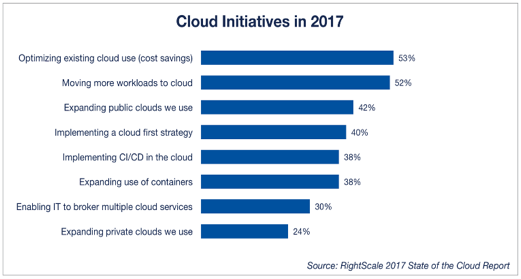What’s Hot and What’s Not in Cloud Computing
Cloud computing trends for 2018
Cloud Computing has been building steam for the past few years, but 2017 might go down as the year it soared. If you’re an IT professional looking for a category that seemingly has no boundaries with endless morphing – this might be the perfect road for you to shift your skill sets into full throttle.
For businesses considering a shift or in the process of making a shift, we’ve spent the past few months aggregating research and trends from a variety of sources to provide a balanced perspective and perhaps help you build a compelling business case:
Security and Encryption
- More than eight in 10 (83%) of the 1,200-global business and IT decision makers polled who plan to use infrastructure as a service (IaaS) believe their cloud service provider takes care of protecting their data in the cloud.
- 56% said they operate with a “Cloud First” mentality vs. 43% still has their mindset on on-premise solutions
Adoption
Veritas – 87% are either using or plan to use two or more cloud providers and 42% are targeting for 2 or more.
Forrester – 38 percent of enterprise decision-makers said they are building private clouds, with 32 percent procuring public cloud services and the remainder planning to implement some form of cloud technology this year.
Forbes –
- Cloud computing is projected to increase from $67B in 2015 to $162B in 2020 attaining a CAGR of 19%. #Cloud
- 74% of Tech CFOs say cloud computing will have the most measurable impact on their business in 2017. #Cloud #CFO
- Gartner – Gartner predicts the worldwide public #cloud services market will grow 18% in 2017 to $246.8B up from $209.2B in 2016.
- IDC – Over 90% of enterprise-scale organizations plan to make use of multiple clouds in the next several years.
Model Trends
CIO/IDG – 59 percent of survey respondents say they’re adopting the hybrid cloud model.
Cloud Academy – Serverless Framework is quickly building steam with AWS leading the way. The estimated global impact has triggered over 60 contributors, such a Twitter and JAWS/VIMEO to a GitHub community pulling all of the necessary resources for programmers and developers to build the necessary skill sets to support the mass migration.

- 85 percent of enterprises have a multi-cloud strategy, up slightly from 82 percent last year.
- 58 percent of enterprises are planning to use hybrid cloud in 2017 vs. 55 percent last year.
- The use of multiple private clouds among enterprises decreased significantly in 2017 to 9 percent vs. 23 percent last year, while the number of enterprises planning to use multiple public clouds in 2017 increased to 20 percent vs. 16 percent last year.
KPMG (businesses $250M> in the next 3 years)
- 56% Platform-as-a-Service (PaaS) adoption is predicted to be the fastest-growing sector of cloud platforms
- 64% will invest in Software- as-a- Service (SaaS)
- 58% will invest in Infrastructure- as-a-Service

Cost Containment
- Optimizing cloud costs is the top initiative for cloud users (53 percent), just ahead of moving more workloads to cloud (52 percent).
- Despite an increased focus on cloud cost management, only a minority of companies report taking critical actions to optimize cloud costs, such as shutting down unused workloads or selecting lower-cost clouds or regions.

ComputerWorld – Forrester
- Monitoring cloud consumption is having the greatest impact – “IT executives will get better at containing cloud costs in 2017 as their best practices mature. And it’s already happening. Forester Analyst – Dave Bartoletti says that a cloud architect for a large software company shaved $300,000 off of a $2.5 million cloud bill by monitoring his consumption. And cost management tools from the likes of AWS, Cloudability and Cloudyn are available.”
Trends and supporting research serve as the basis for businesses cases for future adoption for many of our current clients. The business case becomes the supporting premise to establish compensation budgets and future head counts to support new initiatives. For our thousands of technical professionals, the information is typically used to determine how to modify their personal career paths. Regardless of the reasons, we make a point to stay abreast of the most influential researchers in the technology category. Want to learn more about how we apply trends to support future talent job requisitions? Let’s connect!


